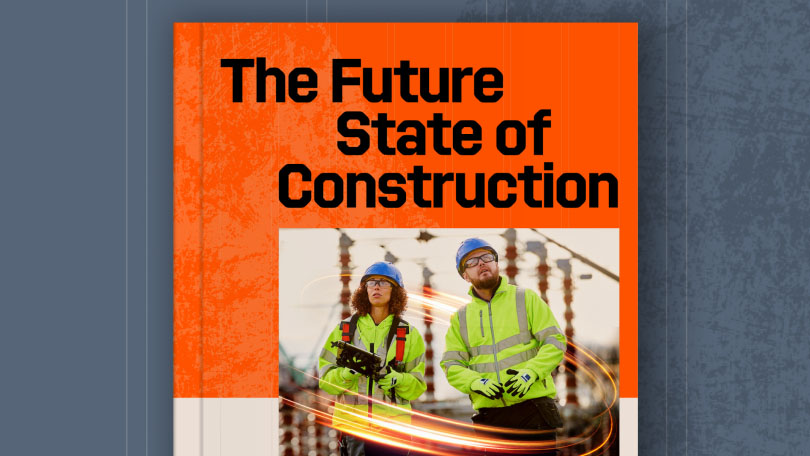— 10 min read
Lean Construction: Principles, Implementation & Benefits


Last Updated Sep 24, 2025

Dave Brown
Product Success Manager
9 articles
Dave is a Product Success Manager at Procore. Previously, he worked for Consigli Construction Co in Boston and Washington, DC as a Project Engineer and Assistant Project Manager, responsible for a variety of activities including bidding and procurement, contracts, and cost control. Dave holds a Bachelor's Degree in Structural Civil Engineering from Bucknell University.

Nicholas Dunbar
Content Manager
62 articles
Nick Dunbar oversees the creation and management of UK and Ireland educational content at Procore. Previously, he worked as a sustainability writer at the Building Research Establishment and served as a sustainability consultant within the built environment sector. Nick holds degrees in industrial sustainability and environmental sciences and lives in Camden, London.

Zoe Mullan
27 articles
Zoe Mullan is an experienced content writer and editor with a background in marketing and communications in the e-learning sector. Zoe holds an MA in English Literature and History from the University of Glasgow and a PGDip in Journalism from the University of Strathclyde and lives in Northern Ireland.
Last Updated Sep 24, 2025

Lean construction transforms project delivery by maximising stakeholder value while minimising waste through better collaboration. Drawing from industrial manufacturing principles, this approach provides project teams with a framework to continuously learn and implement innovative collaboration methods that deliver superior end products within achievable timeframes. Lean construction places intra-team relationships at its core, shifting perspectives away from adversarial dynamics towards more integrated, functional project teams.
Lean construction represents a paradigm shift that brings proven industrial thinking into a sector which, according to the Construction Leadership Council, still loses approximately £13 billion annually to non-value-adding activity.
This article explores lean construction's core principles, benefits, implementation strategies, common challenges, and future outlook.
Table of contents
Core Principles of Lean Construction
Based on the Toyota Production System, lean construction makes work easier for workers while eliminating waste and improving work practices. Understanding these underlying principles helps companies decide whether and when to transition to this system.
Lean construction centres on six core principles:
Value Generation
At its highest level, value generation delivers high-quality products or structures that meet client needs and provide long-term durability. Beyond just meeting specifications, lean construction strives to uncover deeper project meaning, enabling stakeholders to work together towards a common goal.
For instance, building a children's cancer centre transcends erecting walls – it creates a healing space to treat society's most vulnerable members.Flow Efficiency
Bringing structure to construction processes allows teams to break down large, seemingly insurmountable tasks into smaller, manageable components over time. Moreover, numerous methods exist to improve workflow through effective collaborative techniques.
A core component of lean construction involves making everything transparent and visual, simplifying project flow understanding. Collaborative programming frameworks such as the Last Planner™ system Takt and Scrum enable all workers to identify and tackle constraints or roadblocks together, rather than leaving individuals to solve problems alone.Waste Reduction
The waste-reduction principle connects design vision with trade contractors' practical expertise to limit waste. Rework represents a significant waste source, such as installing a wall only to discover incorrect dimensions later. Similarly, snag lists exemplify excess work, leading many lean projects to adopt a "zero punch" goal or mindset. Consequently, rework creates additional costs and effort to correct mistakes, while earlier collaboration helps reduce such issues.
Some waste-reduction practices appear straightforward yet prove challenging to implement. Ensuring "nothing hits the ground" requires using carts for material transport or planning just-in-time deliveries. For example, purchasing all plasterboard for an entire floor simultaneously creates storage issues. Therefore, ordering supplies only as needed reduces material waste but demands accurate planning to ensure teams have the necessary resources when programmed.Continuous Improvement
Viewing issues as improvement opportunities and regularly reviewing and adjusting processes enhances collaboration. Additionally, demonstrating trust and respect for colleagues through open problem discussion leverages each team member's expertise. Lean construction often employs integrated project-delivery contracts where everyone forms one team, making problem identification and resolution less threatening or confrontational.
Respect for People
Respect for people means trusting the knowledge and skills everyone contributes. Shifting perspective from blame to ensuring managers provide proper information, time, supplies, and support creates a culture that values individuals. Respectful teamwork and collaboration underpin all lean construction principles. Creating psychological safety on site through daily "safe-start" huddles encourages open discussion before work begins.
Optimise the Whole
Sometimes, project team members develop "tunnel vision" and focus exclusively on their individual work. This principle encourages workers to shift their project mindset and concentrate on contributing to overall project success rather than merely accomplishing specific tasks. Consequently, this creates an environment where the project's final successful outcome drives decisions, promoting transparency, communication, and open-mindedness.
“Respect for people is number one. You can’t do any of the elements of lean if you don’t trust the other person and respect the knowledge they bring to the table. That’s where a lot of folks need training to unlearn habits and assumptions about job roles and hierarchy. People need to spend the time to understand the guiding principles and get on board with them.”

Dave Brown
Product Success Manager
Procore Technologies
Benefits of Lean Construction
When lean construction projects operate optimally, stakeholder value increases while waste decreases, fulfilling lean's primary goals. However, beyond tangible value, lean construction often leads to more satisfying and positive processes for owners, managers, and workers. The principal advantages include the following:
Efficiency and Cost Savings
Implementing lean construction principles and techniques generates significant efficiency and cost savings. Reducing material waste and worker time decreases costs while still delivering quality projects on programme. Although companies implementing lean for the first time face initial costs, final results include productivity gains, reduced rework and waste, and smoother working relationships. Ultimately, everyone profits and finishes on time without excessive stress.
Quality and Safety
Lean construction also improves project quality and safety. Clear communication and stakeholder involvement in planning deliver better-quality products sooner and for less money. On site safety improves when superintendents and project managers consult teams about their needs and provide the time, materials, and conditions that enable clean and safe work practices.
Getting Started with Lean Construction
Implementing lean construction requires a series of steps and commitment to fundamental changes in mindset and practices. Starting with lean construction demands a cultural shift, training, and adopting new tools and techniques.
Involve Trade Partners Early
When teams provide input during early project stages, they become invested in – and part of – the plan rather than feeling a plan is being imposed upon them. Whether involving design coordination or specialty trades such as mechanical, engineering, and plumbing, subcontractors and specialty trades help main contractors anticipate project needs, reduce errors and rework, and create more accurate programmes.
Train and Build Trust in Project Teams
Building trust is essential for successful lean construction implementation. Training both administrative and field teams helps them unlearn old habits and adopt new dynamics that lean construction may require for certain job roles.
On traditional construction projects, teams generally maintain a narrower focus for project tasks. With lean construction, however, project managers and site managers must work more closely and meet regularly to plan programmes with input from additional project stakeholders.
If team members hesitate to change or adopt more collaborative approaches, hiring a third-party facilitator might help create buy-in for new processes.
Pro Tip
It’s important to note that traditional critical-path-method (CPM) programmes are typically not considered a lean technique. When adopting lean construction, teams can continue to use CPM programmes as a means to identify milestones or conceptual timelines, which are then used to inform other methods.
Introduce Lean Practices in Segments
Lean approaches construction from a different perspective. No single way exists to implement lean; it involves a cultural shift and adopting practices that work best for each team. Lean construction works with design-bid-build or design-build project-delivery methods, but integrated project delivery (IPD) allows contractors and owners to realise lean's full potential.
Lean building methods are gaining increasing popularity in construction, but because construction projects have long timelines, not all companies that want to implement lean have fully adopted it. Many contractors incorporate some lean construction elements, which can shift workflows and result in financial, quality, and collaboration benefits even without fully transforming operations.
Prioritise Collaboration Opportunities
Lean construction uses various tools and techniques to enhance efficiency and collaboration. Structured events such as daily huddles and weekly meetings keep information current and allow for modest continuous improvements.
Pro Tip
A good structure for a daily 15-minute on site huddle is to have everyone go around the room and say what they completed the day before, what they’re working on for the day, and what they’re stuck on. This keeps meeting time short and focused.
Retrospectives are more formal events occurring after significant work scope completion. These give teams opportunities to gather and provide feedback on what worked and what didn't.
Additionally, posting programmes and look-aheads on walls or boards on site ensures everyone remains on the same page. The more eyes on the plan – with feedback mechanisms – the better the plan becomes.
Use Lean Techniques on Pilot Projects
Implementing lean construction on a pilot project enables companies to begin using the process. In pilot projects, cultural shift and new practices start from the first meeting, allowing all participants to learn new habits and workflows together.
Pilot projects help demonstrate lean construction benefits so companies can consider adopting it in future projects. By embracing a continuous improvement mindset, teams can apply what they learned worked well on pilot projects to subsequent projects, while avoiding repetition of unsuccessful approaches.
Measuring Success in Lean Construction
Success in lean construction can be measured using specific key performance indicators (KPIs). The easiest ways to measure success involve checking if projects finish on time or ahead of schedule, stay on or under budget, maintain low incident rates, and avoid snag lists.
Structured feedback mechanisms support continuous-improvement goals. Regularly scheduled meetings with clear agendas allow teams to check progress and adjust plans to maximise efficiency.
Retrospectives scheduled at project segment completion should focus on learning from each phase and improving for the next. Respectful communication in meetings fosters openness, which proves vital for both measuring success and continuous improvement.
Overcoming Lean Construction Challenges
Changing from long-established construction work methods to a lean mindset represents a significant shift for most companies, but creative problem-solving and financial benefits make the effort worthwhile.
Establish Trust in the Project Team
Adopting lean construction involves shifting traditional mindsets. Building trust, especially when implementing new technology or processes, can sometimes be the most challenging aspect. Leveraging outside facilitators can help start conversations and build trust.
Get Stakeholders on Board
Gaining buy-in from all stakeholders – including trade contractors and design teams – becomes easier when all participants engage earlier in the process. Main contractors need to rethink their position in the project team and focus on removing roadblocks for trade partners.
“Getting everyone to buy into the process often starts with lunch. When we were in trouble on a project and needed to go into recovery mode, we put up a big board and invited stakeholders to take a couple of hours and tackle the problems together. Lunch was on us.”

Dave Brown
Product Success Manager
Procore Technologies
Plan for Upfront Costs
Contractors may encounter front-loaded costs for training, hiring consultants, and resource needs when implementing lean construction for the first time, but downstream, they can realise significant cost savings. Being aware of and planning for initial costs beforehand can save contractors from unexpected frustration or unaccounted-for losses when starting this new process.
| Challenge | Lean Response |
| UK regulatory complexity (CDM 2015, ISO 19650, BREEAM, Part L) | Map lean workflows to duty-holder requirements, information-management protocols, and sustainability targets |
| Claims-culture mind-set | Joint risk-reward contracts and shared KPIs |
| Stakeholder scepticism | Demonstrate quick wins from pilot zones |
| Establishing trust | Co-location, open-book cost reporting, and daily stand-ups |
Technology’s Role in Lean Construction
Technology significantly impacts lean construction by enhancing collaboration and efficiency. Many use cases exist for digital tools and automation. Cloud-based BIM, mobile snagging apps, and AI-powered dashboards encourage project teams to work together and receive real-time updates on project changes. Furthermore, documenting progress becomes easier with 360-degree photos and digital software that recognises and stores image content to validate quality and completion.
Communication remains central to lean construction, and software-management platforms help track and maintain information flow and visibility across teams. Having access to project documents, internal and external communications, and updates mitigates information silos. Video-conferencing provides valuable support for geographically dispersed team members to keep projects progressing while personnel work off site.
Future of Lean Construction
Lean construction continues evolving with emerging industry trends and will gradually appear on more projects. Emerging trends that work well with lean include the rise in modular construction and increased prefabrication practices.
At its essence, lean construction centres on early stakeholder involvement, visibility, and collaboration. As more owners and contractors recognise lean's value, the construction industry's culture and practices can shift towards increased project efficiency.
Categories:
Financial Management, Project Management, Resource Management, Tech and Data
Written by

Dave Brown
Product Success Manager | Procore Technologies
9 articles
Dave is a Product Success Manager at Procore. Previously, he worked for Consigli Construction Co in Boston and Washington, DC as a Project Engineer and Assistant Project Manager, responsible for a variety of activities including bidding and procurement, contracts, and cost control. Dave holds a Bachelor's Degree in Structural Civil Engineering from Bucknell University.
View profile
Nicholas Dunbar
Content Manager | Procore
62 articles
Nick Dunbar oversees the creation and management of UK and Ireland educational content at Procore. Previously, he worked as a sustainability writer at the Building Research Establishment and served as a sustainability consultant within the built environment sector. Nick holds degrees in industrial sustainability and environmental sciences and lives in Camden, London.
View profileReviewed by

Zoe Mullan
27 articles
Zoe Mullan is an experienced content writer and editor with a background in marketing and communications in the e-learning sector. Zoe holds an MA in English Literature and History from the University of Glasgow and a PGDip in Journalism from the University of Strathclyde and lives in Northern Ireland.
View profileExplore more helpful resources

Construction Management Contracts: A Complete UK Guide
Managing construction contracts can lead to an extensive physical paper trail. Sharing contracts, getting signatures and managing timelines is difficult when teams and clients are scattered across job sites and...

Key Differences Between Contractors & Subcontractors
In UK commercial construction, main (or principal) contractors engage directly with project owners to deliver complete construction programmes, while subcontractors perform specific scopes of work under the main contractor’s management....

The Role of RFPs in UK Construction Projects
Requests for Proposals (RFPs) are a core document for construction procurement in the United Kingdom. Effective RFPs align expectations, establish clear evaluation criteria, and create accountability between clients and contractors....

Financial Management in Construction Projects
Effective financial management can make or break construction projects. Teams that master budgeting, cash flow and cost control are better positioned to deliver projects on time, within budget and with...
